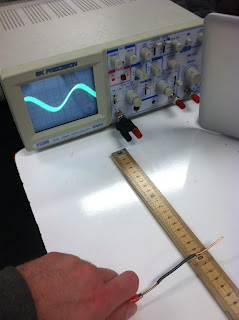Materials:
- copper wire
- leads
- frequency generator
- oscilloscope
- ruler
- BNC adapter
Set Up:
We used three tests to make sure what we were doing was influencing the image on the oscilloscope.
1. changing the distance between the metal rod and the oscilloscope
2. changing the voltage on the oscilloscope
3. changing the frequency on the frequency generator
Data:
| distance (m) | # of divisions peak to peak | vertical scale | peak to peak amplitude (mV) |
| 0.00 | 4 | 50 | 200 |
| 0.05 | 4 | 10 | 40 |
| 0.10 | 2.25 | 10 | 22.5 |
| 0.15 | 2 | 10 | 20 |
| 0.20 | 1.8 | 10 | 18 |
| 0.25 | 3.5 | 5 | 17.5 |
| 0.30 | 3.2 | 5 | 16 |
| 0.35 | 2.8 | 5 | 14 |
| 0.40 | 2.4 | 5 | 12 |
| 0.45 | 2 | 5 | 10 |
| 0.50 | 1.6 | 5 | 8 |
| 0.55 | 1.2 | 5 | 6 |
Trig Variant: We used a A/r and A/r2 function to fit the data.
Graph of A/r
Graph of A/r2
Graph of A/rn
Summary: Because the transmitter isn't a point charge it sends waves in all different directions so the closer the transmitter it to the receiver the graph will look more like 1/r. IF the transmitter is far away, then the graph will look more like 1/r2.






No comments:
Post a Comment